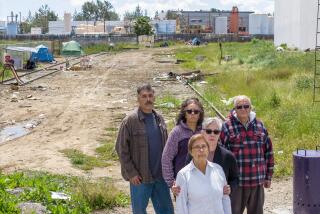State high court clarifies environmental law’s impact on development
The California Supreme Court ruled Thursday that public agencies reviewing a development proposal generally do not have to consider the effects of environmental conditions on future occupants unless the project itself would worsen those conditions.
“It is the project’s impact on the environment — and not the environment’s impact on the project — that compels an evaluation of how future residents or users could be affected,” Justice Mariano-Florentino Cuellar wrote in the court’s unanimous decision.
Cuellar cited the example of an abandoned gas station that had permitted toxic chemicals to leach into the soil or groundwater. Without any additional development, the contamination “might well remain locked in place,” he said.
But if a proposed project threatened to disperse the contaminants, making the problem worse, a government agency would have to evaluate the conditions in its environmental review, he wrote.
The decision clarified the scope of the California Environmental Quality Act, a law that has clogged the courts with lawsuits and stalled or killed developments.
The court case began when the California Building Industry Assn. sued air quality regulators in the Bay Area over guidelines issued in 2010. The Bay Area Air Quality Management District protocols were designed to address the health consequences of urban infill development near transportation corridors with higher air pollution.
The decision gave the building industry and environmental regulators some of what each wanted.
Nick Cammarota, general counsel of the building association, said the group was pleased that the court found the environmental law “does not require a project to evaluate and mitigate impacts that the existing environment has on the project.”
He said the ruling would help builders win approval of infill development, which is often challenged as a detriment to future residents because of existing air pollution.
If the court had ruled the other way, new residential development would have had to shoulder “the burden of evaluating and mitigating existing air quality problems,” he said.
Ellison Folk, who represented the Bay Area air district in the case, said most projects contribute to existing environmental hazards and under the ruling, their effect on future residents will continue to have to be examined.
“Most will emit toxic air pollution because they generate vehicle traffic or if someone is building a new residential development in an area with a fire hazard, the new development increases the fire risk,” Folk said.
But she said agencies will not have to assess the risk to future residents of building on an active earthquake fault, for instance, unless the proposed project would increase the risk of an earthquake.
“It is going to be a case-by-case determination,” she said
Environmental law experts said the decision’s immediate effects are unclear because it did not invalidate lower court rulings that have favored home builders by narrowing the scope of environmental reviews.
“This is not even close to the final say,” said Sean Hecht, a law professor at UCLA. “The court really left wide open the possibility that environmental impact might be found in a wide range of situations, but it left it for other courts to figure out.”
Richard Frank, director of the California Environmental Law and Policy Center at UC Davis, called the ruling a “qualified win” for environmentalists. Frank wrote in a blog post that the decision is “unlikely to fully satisfy either side in the litigation, though over the long-term it would seem to favor local regulators and their environmental allies over development interests.”
Twitter: @mauradolan
Twitter: @tonybarboza
More to Read
Start your day right
Sign up for Essential California for news, features and recommendations from the L.A. Times and beyond in your inbox six days a week.
You may occasionally receive promotional content from the Los Angeles Times.








